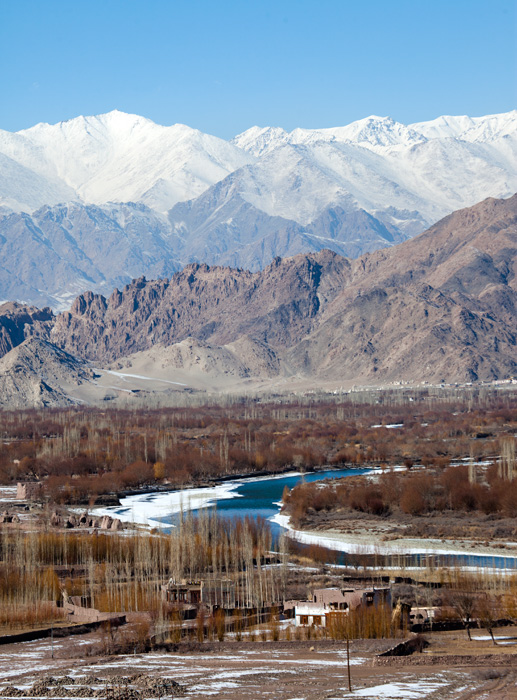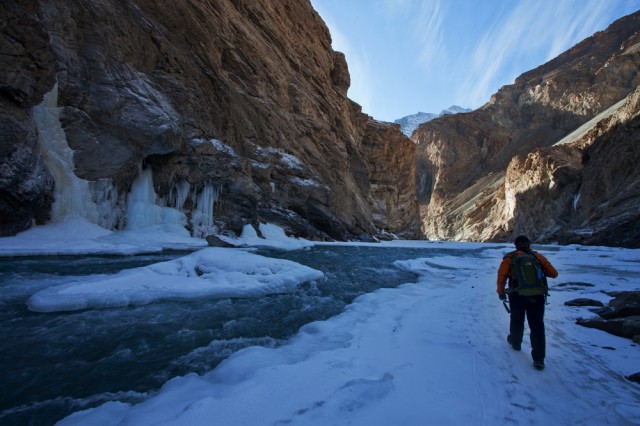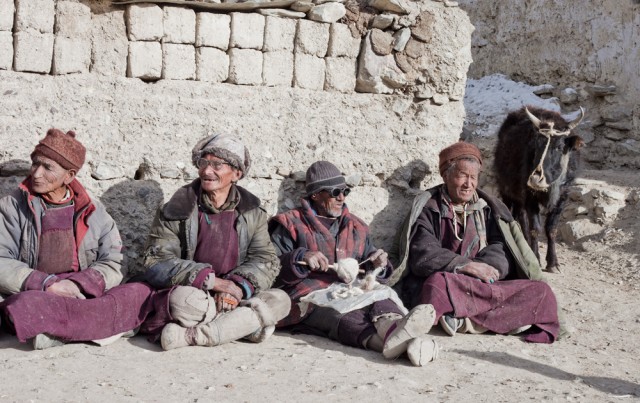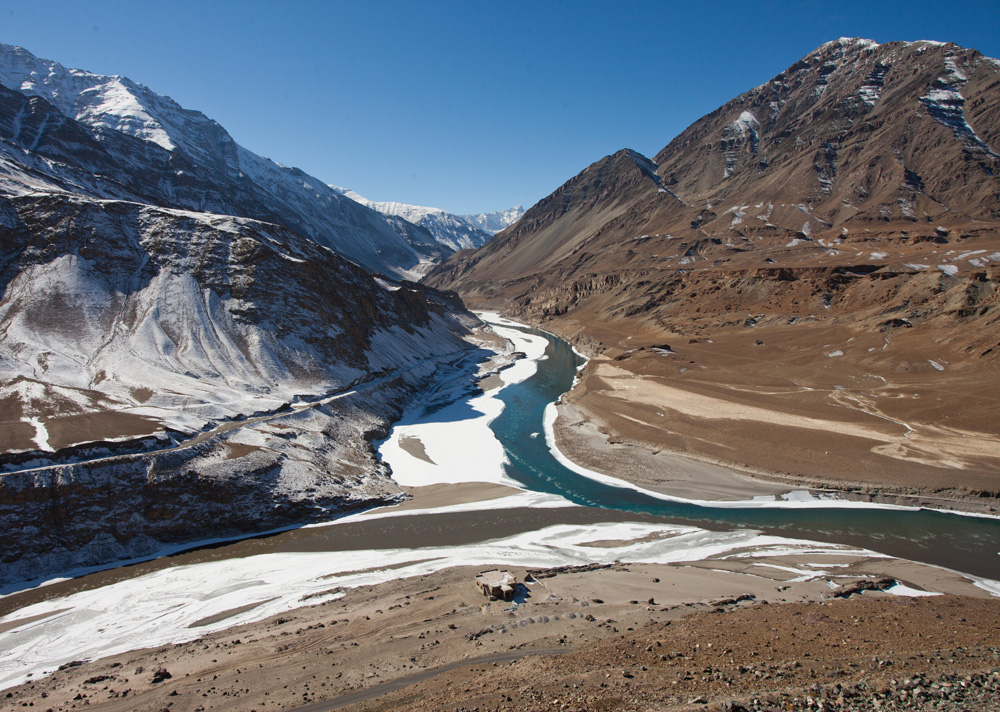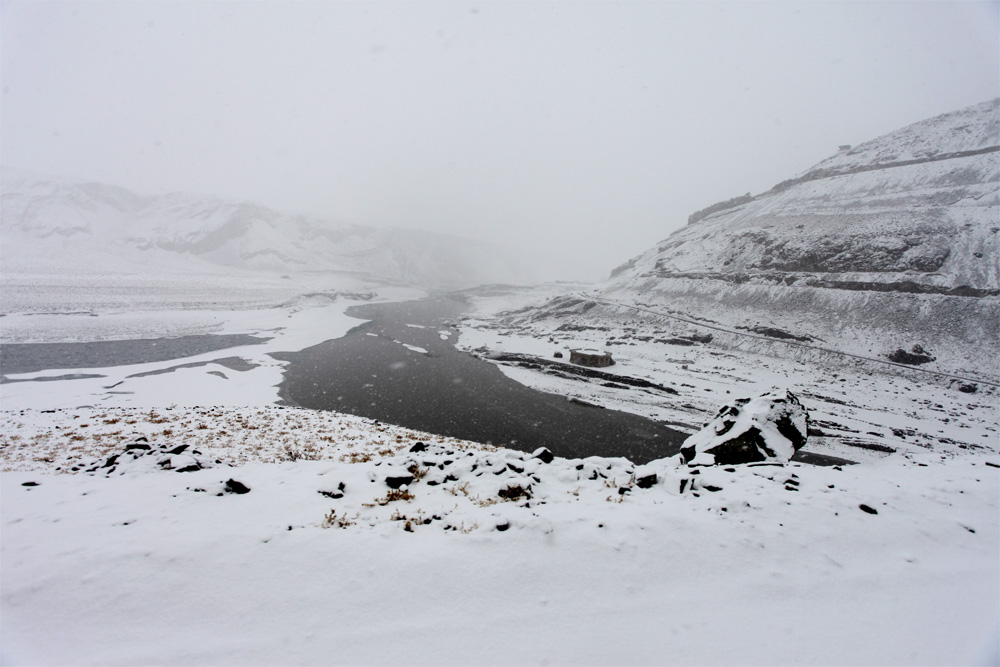Ladakh in Winter
As I plan and prepare for my second visit to Ladakh this winter in search of a frozen Pangong Lake, here is a short take on Chadar Trek and experiencing Ladakh in winter months.
Every year, ‘Ladakh Season’ begins some time in June and ends in September-October months. This is the fair weather time in Ladakh and is the best time to visit. This is also the time when the roads leading to Leh from Manali and Srinagar remain open. From late September or early October, weather gods cast their angry-eyes on this region and let the clouds play havoc on the mountains. Rains bring down tonnes of slush on the roads to Ladakh and snowfall makes things worse at high passes. Temperature dips closer to zero and goes further down with the progress of winter. Temperatures twenty below zero become an everyday affair from December to February. Naturally, the streets of Leh that used to be filled with visitors in summer now go nearly empty. Very few people make it to Ladakh in these months, thanks to the difficult weather and closed roads.
Landscapes of Ladakh in winter with Indus flowing through the mountains.
The landscape too, gets transformed during the winter months. Rivers that were running full in summer, thanks to the melting glaciers, now slow down. The barren mountains are now adorned with snow. Whatever few trees that exist in the valley shed their leaves and go naked. The fields that were filled with barley too, become either brown or white with snow. The sky however, becomes unpredictable: it is either stark blue or masked with clouds that precipitate powdery snow.
In summer months, Ladakh’s clear blue skies, stark landscapes and the deep valleys appear magical. As the temperature dips and the mountains prepare for a long winter, the transformation creates another kind of magic. It is made of deep blue rivers lined with ice on either banks, tall poplar groves that stand bare and parallel to each other, mountain peaks that keep changing colours from brown to white depending on the weather.
When it comes to people of Ladakh, life takes a slower pace in winter. The markets that cater to tourists shut down. The tourists walking on the street, who could be from any part of the world, disappear completely. The few people who are on the street are all round-faced, apple-cheeked Ladakhis going around doing their daily shopping.
In 2011 January, I made a winter visit to Ladakh and was amazed by the transformation that the landscape went through. I had seen it in pictures and knew what to expect, but as it always happens, the magnificence that unfolds in front of your eyes can’t be substituted by a two-dimensional post-card sized splash of colours. I was overwhelmed. I was taken. The winter time Ladakh had conquered me as soon as our aircraft landed at the airport in Leh.
Thiksey Monastery in winter.
I spent two weeks in Ladakh then, visiting a few monasteries that are typical tourist hangouts during the summer months, and then walking on the frozen Zanskar River in the excellent stewardship of Manish Lakhani, whose name is highly respected on the unpredictable tracks of Chadar. Having spent more than two months in Ladakh, I had assumed that I know plenty about the region. But this time, it all looked new. And different. The monastery at Thiksey was unpeopled, but for the caretaker monk in the Buddha Room who smiled at us genially. Empty landscapes and a super-blue Indus welcomed us at Stakna. The river that was in a great hurry during summer months, then filled with sediments it brought from faraway Tibet, was now clear and challenged the sky in its blueness.
Chadar Trek–the walk on the frozen Zanskar River–showed me a world that I had never known, a world that is hard to imagine it exists. Even when I had seen it in pictures. We lived for twelve days camping by the river during the night and walking on it during the day. On the way, we encountered waterfalls that had given in to the cold and had frozen on their way down the cliff. We saw whirlpools of water in Zanskar forming lily-like plates at the edge of the water. We walked on sections of the river where the it formed deep gorges, flowing between steep vertical walls. There were places where the river was frozen hard, forming a thick ice that could not even be broken by tonnes of heavy stones that fell from the mountains. At places, air bubbles showed through the transparent-blue ice. There were places where the ice was so fragile, we ended up having to walk in the frigid waters (not an experience I would want to repeat!).
Chadar Trek – walking on the frozen Zanskar River.
As the days progressed over the Chadar, the landscapes changed one day and the steep inaccessible mountains made way to a wide open valley. Near Hanumil Village, where the habitation begins in Zanskar Valley, we could leave the river bed and walk on the gentle slopes. It is astonishing to see a civilization thriving in a place so remote and forbidden.
People of Zanskar once lived with the help of their livestock and subsistence farming. They consumed what they produced, relying on external world for very few essentials like salt, which was traded for yak butter. While there were many routes to connect with the external world during the summer months, the mountains routes were buried in snow during the winter. However, the river came to rescue when the mountains would not. The frozen river provided a faster, easier access to people of Zanskar with the outside world. This remains true remains even today. Once the snowfall begins in November, the roads to Zanskar are cutoff and river becomes the road that connects people with rest of the world.
People of Zanskar, where life hasn’t changed much over the past centuries.
Much like the tradition of using the river for winter transport, lives of Zanskaris hasn’t changed much over the centuries. People still live largely on subsistence farming and depend considerably on their livestock. But income is supported by activities associated with tourism in the last few decades. In winter, a large pool of locals double up as porters for visitors who want to trek on Chadar. Business is generated in summer months by a continuous stream of visitors who come here to see places, go rafting or trekking. The roads, as long as they are open, also bring in modern facilities. Zanskar today has limited access to electricity, roads and reasonably good facilities to educate local children. Cooking gas cylinders have replaced cow-dung and wood. Yet, for a visitor who comes here in winter, it is difficult to digest the fact that a civilization happily thrives here despite the harsh conditions, living far more contented than the people in the plains.
This is how things changed with weather at Nimu, the confluence of Indus and Zanskar Rivers.
We had clear blue skies as we walked upstream into the heart of Zanskar. On our way back however, weather gods decided to show us their powers. One morning, we woke up to see that the sun had disappeared behind thick, low-hanging clouds. It kept snowing for a long time, rarely offering any breather all through our return journey. Once again, the landscape was transformed. Fresh, powdery snow took the place of hard ice. Blue skies had changed colour and visibility had dipped. The confluence of Indus and Zanskar Rivers, which was an aesthetic mix of deep blue and mountain-brown when we began the trek, had turned into shades of grey when we ended. During the drive back to Leh, we did not see the road but a thick white line with little bit of tarmac showing up once in a while. The mountains hid behind the falling snow and there was nothing visible except the falling snow right ahead of us. With a continuous snow fall, my Ladakh experience was as complete as it could get. I had spent a summer here, relishing the balmy weather and driving through the high passes. I had seen rainy days when floods washed away our roads. I had seen clear-blue-sky days in summers and winters. Now, just as I was ready to depart after a long and tiring trek, Ladakh had transformed again and showed me yet another face that I had not seen before.
Also see: our photography tour to a Snow filled Ladakh in Winter.
